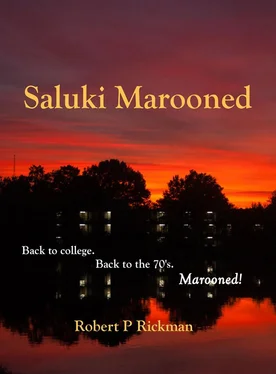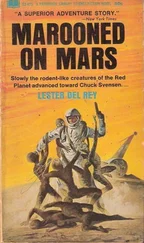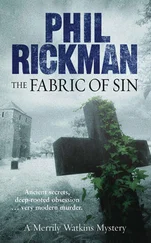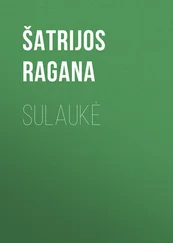Robert Rickman - Saluki Marooned
Здесь есть возможность читать онлайн «Robert Rickman - Saluki Marooned» — ознакомительный отрывок электронной книги совершенно бесплатно, а после прочтения отрывка купить полную версию. В некоторых случаях можно слушать аудио, скачать через торрент в формате fb2 и присутствует краткое содержание. Жанр: unrecognised, на английском языке. Описание произведения, (предисловие) а так же отзывы посетителей доступны на портале библиотеки ЛибКат.
- Название:Saluki Marooned
- Автор:
- Жанр:
- Год:неизвестен
- ISBN:нет данных
- Рейтинг книги:5 / 5. Голосов: 1
-
Избранное:Добавить в избранное
- Отзывы:
-
Ваша оценка:
- 100
- 1
- 2
- 3
- 4
- 5
Saluki Marooned: краткое содержание, описание и аннотация
Предлагаем к чтению аннотацию, описание, краткое содержание или предисловие (зависит от того, что написал сам автор книги «Saluki Marooned»). Если вы не нашли необходимую информацию о книге — напишите в комментариях, мы постараемся отыскать её.
Saluki Marooned — читать онлайн ознакомительный отрывок
Ниже представлен текст книги, разбитый по страницам. Система сохранения места последней прочитанной страницы, позволяет с удобством читать онлайн бесплатно книгу «Saluki Marooned», без необходимости каждый раз заново искать на чём Вы остановились. Поставьте закладку, и сможете в любой момент перейти на страницу, на которой закончили чтение.
Интервал:
Закладка:
Chapter 3
I awoke to a dark, empty train car with the photo of a young Catherine in my lap, and placed it carefully into my shirt pocket. Through a dripping window I saw maroon-tinted, luminescent clouds descending over the roofs of old brick and wooden buildings burnished by light drizzle and stained orange by streetlights. The buildings were vaguely familiar, but distorted by an imperfect memory made decades ago. I had walked past these buildings many times during the two years I had attended SIU in the early 1970s. But the trees were different; many had entire limbs missing, and there were stumps here and there along the street. I had read about this. An inland hurricane had blasted through the region in May and left such incredible damage that it was still being cleaned up months later.
When I stood up, the blood drained from my head, leaving a thick sludge that weighted my head so that I was looking down at my feet. The sludge shifted ponderously around as I reeled to the exit door, slipped on the wet train steps, and landed in a heap on the ground.
Welcome to Carbondale!
With the help of a lamppost, I pulled myself to my feet and stood swaying like a bottom-heavy blow-up clown, then stumbled out onto the sidewalk and started a shambling walk down Illinois Avenue—the main drag—until I reached a coffee shop. The ache in my shoulder reminded me of last year’s brawl at Demonic Grounds, and I didn’t need a visit from the gremlins, so I chose to stay outside and behave myself. Yet I hung around the shop’s entrance, curious to see what modern SIU students looked like.
At first glance, they didn’t look much different than my generation did in the early ‘70s. Except: A kid walked in the door with a tastefully camouflaged backpack fitted with compartments for his laptop, cell phone, iPod, and one of those blessed water bottle-things we never had in the ‘70s. In the Vietnam era, students wore Army surplus backpacks with something like a peace symbol sewn raggedly on the flap.
The door to the shop edged open and a coed (Do they call them that anymore?) left the shop while awkwardly balancing three cups of coffee in her hands in an effort to avoid spilling them on her Versace jeans. When I attended SIU, I walked around in beat-to-hell combat boots, and our “designer” jeans were stiff-as-a-board bellbottoms that took a month of washings to soften up. Fashion-conscious students tie-dyed the jeans in the bathtub, then wore them until they fell apart—and no one gave a damn what was spilled on them.
Inside the shop, a petite girl sitting with a swimming pool-sized cup of coffee was sporting a short, razor-cut hairstyle, dyed the SIU colors—maroon with white streaks—and the guy sitting across from her had the same hairstyle, but in brown. In the ‘70s, our hair wasn’t “styled.” We either cut it ourselves or went to an old-fashioned barber and hoped he didn’t cut off too much. We wore our hair stacked on our heads like leaves of lettuce piled in a salad bowl or splayed out in all directions like frazzled steel wool pads. And no one thought of dyeing his or her hair maroon, pink, or any other color, because we wanted it to look “natural.” Besides, SIU students of the early ‘70s didn’t have that much school spirit, and except for an occasional school sweatshirt, we didn’t wear maroon and white.
I noticed a youth sitting on a paisley cushion and playing a guitar, who looked like he had been teleported there from 1971. The kid affected a scraggily beard and wore a torn T-shirt, dirty jeans, and scuffed combat boots. But the outfit looked too perfect, as if he had seen an old photo of a genuine hippie on the Internet and had practiced dressing like him. I suspected that behind the façade lurked a squeaky-clean college student, circa 2009.
But I did notice a hint of genuine rebellion in this coffee shop crowd, because students wore glasses with larger lenses than what most people wore in 2009, probably because small lenses were “in” for everyone else, which meant they were “out” for college students. But, aside from this mild ophthalmological revolt, the rebellious look of the ‘70s was no longer rebellious—it had been studied and refined until it was the standard for the 21st-century student.
Two guys tried to exit the shop at the same time and got stuck in the door.
“Sorry,” said one guy.
“Excuse me,” said the other.
Such politeness! In the ‘70s this place would probably have been a bar, the two students probably would have been drunk and stoned, and their abrupt meeting would probably have led to a fight.
Yet there was something particular to SIU that stretched across the generations. A few students almost furtively came through the door of the coffee shop, slumped over, and sat down with sheepish looks, as if they had been beaten into submission by the very act of attending Southern and felt they didn’t deserve to be in such a nice place as this one. I remembered the “Saluki slump”—Harry, my roommate, slumped liked that every time he entered our dorm room. But his was an arrogant slump, as if to say, “I’m here, no big deal, unless you want to make something of it.”
I stood outside the coffee shop window, staring at this terrarium of student culture, and the students stared right back at me, as if mesmerized by a poisonous snake. I could see why, because my reflection in the shop window showed two demonic eyes staring a thousand yards into the distance, with the red pupils almost indistinguishable from the bloody whites. It was a face that was anything but normal. I looked down, saw the footprints of an impossibly big dog painted on the sidewalk, and followed them south.
Just ahead was Pizza King. PK’s never served pizza while I lived in Carbondale, but I drank a lot of beer there, and the suds were flowing that night. However, across the street, the Golden Gauntlet nightclub was now a pet store.
Sad.
I sensed there was more missing, a lot more, but I didn’t see it immediately, so I stared down the street until it came to me.
The Strip is gone!
The Purple Mouse Trap, Das Fass, Jim’s, Bonaparte’s Retreat, the Golden Gauntlet and The Club were all missing. All of the bars along the southernmost three blocks of South Illinois Avenue had transmogrified into nice-looking, nearly upscale bicycle stores, donut shops, fast food restaurants, and places like the one I was standing in front of. The display window showcased several life-size dolls that resembled greyhounds with long floppy ears. The Saluki dolls were sitting in a circle of maroon and white megaphones, looking up in admiration at a female mannequin that was wearing absolutely nothing, not even hair.
Salukis and maroon and white in business windows meant the merchants now had school spirit, which was different from my time, when business owners rarely hung anything in their windows that reminded them of SIU. The conservative Southern Illinoisans frowned on student riots and impromptu street parties downtown. And they looked askance at the bombing of the Agriculture Building in 1968, the burning of Old Main in 1969, and the closing of the university during the spring riots of 1970. What a difference forty years had made: Carbondale had gone from a jumble of low-rent businesses to an average, respectable university town: clean, orderly…and boring.
Yet there was one thing that separated Carbondale from other college towns, and that was size. The population had been 25,000, more or less, for decades, which made it a small town. On the other hand, SIU, to the south, had a maximum enrollment of 24,000 students, which made it the 24th largest university in the country in 1970. Very few huge institutions like SIU are located in isolated small towns, thirteen miles from the closest interstate, in a world of their own.
Читать дальшеИнтервал:
Закладка:
Похожие книги на «Saluki Marooned»
Представляем Вашему вниманию похожие книги на «Saluki Marooned» списком для выбора. Мы отобрали схожую по названию и смыслу литературу в надежде предоставить читателям больше вариантов отыскать новые, интересные, ещё непрочитанные произведения.
Обсуждение, отзывы о книге «Saluki Marooned» и просто собственные мнения читателей. Оставьте ваши комментарии, напишите, что Вы думаете о произведении, его смысле или главных героях. Укажите что конкретно понравилось, а что нет, и почему Вы так считаете.











